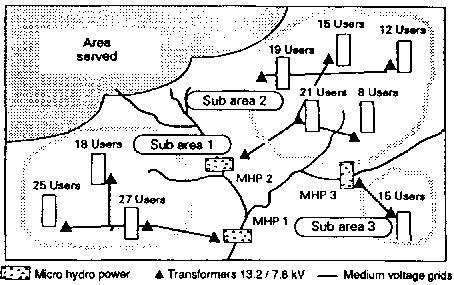

| Micro-Hydroelectricity Potential in Rural Areas |
In the remote and poor Northeastern province of Misiones in Argentina, the Instituto de Economia Energética has developed a method for identifying micro-hydroelectricity potential over large areas of remote countryside and matching it with the electricity required by rural households.
The method was developed to identify the lowest cost option for providing electricity to rural areas, as well as to provide economic information and policy recommendations for policymakers.
Although the importance of energy to rural communities is recognized, the provision of electricity has been hampered by low population densities and the limited purchasing power of rural people. The research undertaken by the Rural Energy Technology Assessment and Innovation Network (RETAIN) in Misiones showed that decentralized micro-hydro plants can be an attractive alternative to trying to integrate rural areas into a "central grid" system.
Three alternative micro-systems were studied:
Micro-hydro systems, consisting of easily built dams on small rivers and streams (using earthfill and rocks), connected to a micro-turbine and generators. The capacity ranges from 4 to 50 kilowatts (enough for one family or a few households).
Thermal systems, fueled by diesel or gasifiers using charcoal (capacity 4 to 50 kilowatts).
Wind systems, using a three-blade design, direct current generators and storage batteries.
The method for identifying the potential of these small energy sources consists of six modules:A "diagnosis" of the region's socioeconomic and energy situation, including the underlying processes of wealth creation and their effect on energy consumption;

FigureA survey of energy requirements, based on an analysis of people's energy needs as distinct from their ability to pay (up to 70% of electricity needs can't be paid for by rural users);
An assessment of the potential of the area to supply energy from different sources;A map of electricity needs overlaid with the locations of potential micro-plants, as well as existing power stations and distribution lines;
An evaluation of alternative packages, i.e., central grid electricity, decentralized micro-plants (thermal, hydro, or wind), or combinations of the above, with cost comparisons;
Development of preliminary policy recommendations, including the impact of different options on elements of the macroeconomy, such as employment, the development of local industry, and the use of foreign exchange.
The project has gone on to a second phase to look at the legal, institutional, and financial mechanisms for using decentralized micro-hydro plants, as well as potential markets and the necessary planning for organizing and managing decentralized systems. This includes looking at the availability of credit from financial institutions, the availability of local suppliers and the ability of people to install and maintain the equipment.
As well, research is being done on how small-scale microhydro plants can be replicated over larger areas, and how they can be integrated with a central electricity system (for example, by transfering subsidies from the central system to users of micro-hydro plants). They are looking at how to overcome opposition to decentralized provision of electricity and have already had an impact on policy-makers and energy companies in the country.
Potential users
Rural people would be the main beneficiaries of a small-scale electricity supply system. The method for assessing its potential can be used by governments, utility companies, NGOs, and policymakers wishing to expand microhydro projects to a full-scale rural system of electricity supply, and to overcome resistance to integrating small-scale systems within the central grid. Some interest has already been shown by policymakers and utility company officials in Argentina.
Contact
Mr Daniel Bouille Instituto de Economia Energética Piedras 482 - 20H, 1070 Buenos Aires, Argentina Tel.: 54(944)22050 Fax: 54-1-34-5437

